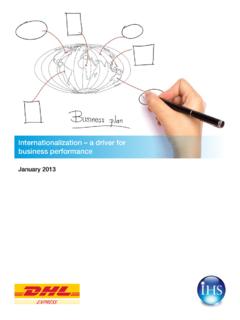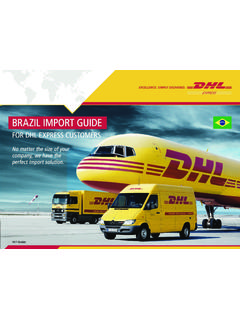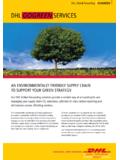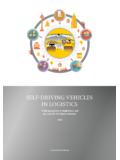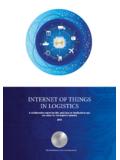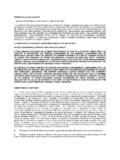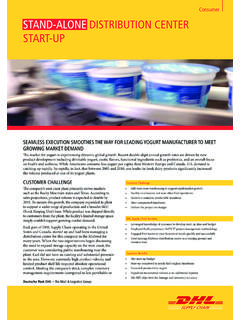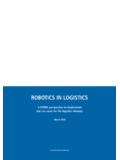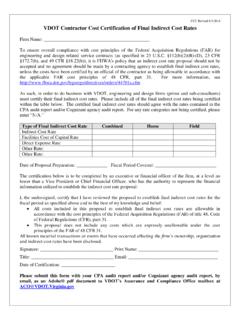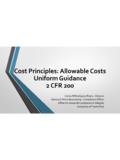Transcription of mro indirect supply - DHL
1 Mro indirect supply :driving new efficiencies in the indirect supply chainprocurement & logistics strategies for maintenance, repair and operations (mro) suppliesa white paper from the americas leader in supply chain managementPAGE 2In challenging economic times, companies look for new ways to control costs and improve efficiency. To address these issues, manufacturers are taking a hard, strategic look at Maintenance, Repair and Operations (MRO) supply . Commonly known as indirect materials, MRO supply includes a vast array of items that support internal operations, ranging from safety gloves and office supplies to spare parts for mission-critical industrial equipment and tooling. Many companies have focused cost-cutting efforts on direct materials and capital spending rather than MRO supplies, which have traditionally been viewed as low-cost items with little potential for savings.
2 However, there is growing recognition that MRO represents a substantial expense for manufacturers about $125 billion annually, according to a 2008 study by Frank Lynn & a typical manufacturer MRO expenses represent up to 16 percent of the cost of goods but 62 percent of total requisitions. MRO supply is also a complex process, with thousands of stock keeping units (SKUs), fluctuating demand and hundreds of individual suppliers, often managed at a local or site level rather than corporate procurement. Given the large volume of transactions, unpredictable demand and de-centralized management, the MRO supply chain has long been ripe for efficiency and cost savings , companies have sought to streamline MRO supply since the 1980s by outsourcing purchasing, inventory and other functions to integrated suppliers that provide a solution offering centralized procurement, systems support and a single point of contact.
3 Integrated outsource models provide some advantages compared with traditional MRO supply models that typically operate with limited resources. However, companies are finding that the integrated model s bundled service and pricing structures do not always provide the visibility needed to eliminate waste and inefficiencies while improving the productivity of maintenance teams. As a result, leading manufacturers are beginning to un-bundle outsourced services to implement lean processes that provide better visibility and promote continuous improvement in every aspect of the MRO supply chain. This enhanced outsource model leverages the expertise of an MRO supply Chain Manager that works with partner companies offering deep expertise in each area of MRO supply strategic sourcing, procurement, transaction management, logistics and others.
4 This high-performance team leverages lean principles to deliver greater value and service levels through the supply base, streamline inventories and improve administrative shown in Figure 1, the benefits of an efficient MRO supply chain are significant. This white paper will help decision makers in a wide range of industries understand how expertise-driven MRO outsource models reduce cost and complexity while putting the control and ability to drive further efficiencies back in the hands of the SUMMARYF igure OF AN EFFICIENT MRO supply CHAINS ource: supply Chain Management ReviewBest in classAverageLaggard19%7%3%14%8%2%17%9%3% 18%7%2%MRO Savings Over the Last 12 MonthsMRO Inventory Reduction for the Past 3 YearsMRO supply Base Reduction for the Past 3 YearsAdministrative Cost ReductionBest-in-class companies have reduced MRO costs by 19 percent, according to the Aberdeen Group Study.
5 The study found a wide gap between best-in-class, average and laggard companies among 150 firms 3 Historically, MRO supply functions have operated in a silo separate from many companies primary strategic purchasing operations. While most purchasing activities have moved to centralized procurement professionals, indirect supplies have continued to be managed at a site level with little or no system recently, information management systems could not track the large number of individual indirect supply items required for a manufacturing facility and, more importantly, provide visibility into the demand for any given product. As a result, MRO goods are ordered in bulk and then stored in warehouses until they are needed by end users. This translates into an increased cost of ownership for MRO inventories, high obsolescence rates and low levels of productivity for highly skilled plant personnel who spend spent too much time looking for critical parts among thousands of other indirect supplies in storage at the same traditional approach to MRO supply creates five key End USERS LACK A COMPLETE UndERSTAndInG And TRAnSPAREnCy OF MRO COSTS.
6 MRO supplies represent almost two-thirds of a company s requisitions yet companies lack comprehensive tracking systems that provide visibility into the total cost of ordering, warehousing, transporting, receiving, payment and other supply chain costs. These expenses typically represent about half the total cost of MRO supplies (Figure 2).2. supply CHAInS ARE FRAGMEnTEd And InEFFICIEnT. due to the wide variety of MRO materials required by manufacturers, many suppliers are involved. Maintaining numerous business relationships adds cost to the supply chain due to the labor and systems required to order, audit, pay invoices, transport, and provide other essential tasks. CHALLENGES WITH TRADITIONAL MRO supply Figure MRO COST OF OWNERSHIPP rice of MaterialsOther CostsCostsWarehousingCarrying InventoryObsolescenceTransportation OrderingTrackingAdministrationDutiesTaxe sDepreciationPrice of MaterialsThe goal: look beyondprice to analyze lessobvious : Exel AnalysisPAGE 4 CHALLENGES WITH TRADITIONAL MRO supply (CONT.)
7 MRO OUTSOURCE MODELS3. MAnUFACTURERS LACK vISIbILITy InTO THE MRO supply CHAIn. Product and process manufacturers, alike, may have thousands of MRO items to manage. Without full visibility into supply and demand, companies may over-stock items, resulting in unnecessary inventory carrying costs, or find that key supplies are often out-of-stock, leading to inefficient operations or loss of productivity. 4. SKILLEd MAInTEnAnCE/EnGInEERInG STAFF SPEnd TOO MUCH TIME ORdERInG, FIndInG And PICKInG UP PARTS. Maintenance personnel work in high-intensity environments where uptime is critical. Pit stop maintenance is essential to get equipment reconditioned and back into production as quickly as possible while ensuring safety. Maintenance professionals need essential MRO materials delivered where they need them, when they need them.
8 5. MULTIPLE SUPPLIERS EnTERInG THE MAnUFACTURInG SITE CREATE SAFETy And SECURITy ISSUES. Allowing multiple suppliers to make on-site deliveries creates a variety of risks, ranging from accidents and warehouse congestion to potential security threats. by limiting access to trained personnel familiar with the site, manufacturers manage risk more address these issues, companies have recognized that the strategies that have helped them drive waste and inefficiency out of their operations can be applied to MRO supply . While some decide to tackle these MRO challenges on their own utilizing internal resources and systems, a large number of Fortune 500 organizations have gone outside their organizations to seize the opportunity more primary MRO outsourcing models are: Integrated model, where companies outsource the entire MRO supply chain to a single external provider as a service bundle (procurement, logistics, inventory and on-site management); and Expertise-driven model, where companies outsource to a lead MRO supply Chain Partner who unbundles the supply chain functions and manages a limited number of best-in-breed companies with expertise to streamline each phase of the procure- to-pay process.
9 According to a 2008 study by Frank Lynn & Associates, these outsourcing models currently manage 11 percent, or $14 billion of the $125 billion MRO marketplace spend in the industrial industry alone. Technology, chemical and consumer product manufacturers are also exploring new MRO supply models in an effort to manage costs. MRO outsourcing is expected to continue at annual growth rates of 10 to 25 percent. InTEGRATEd OUTSOURCE MOdELThe integrated supply model, which first emerged in the 1980s, represents a basic outsourcing model of the entire MRO supply chain to an external provider. Common stock inventory items ( safety gloves and glasses) are sourced from an integrator often a large industrial distributor that has expanded its product catalogue to include these items and developed in-house transaction processing and inventory systems to provide a broader range of services.
10 This model has been used primarily by automotive, aerospace and petrochemical industries, in which companies MRO expenses are more than $ million per facility. PAGE 5 MRO OUTSOURCE MODELS (CONT.)About 39 percent of industrial distributors currently manage integrated supply contracts, according to a survey by Industrial distribution. Frank Lynn & Associates defines an integrated supply program as one which includes: On-site management of MRO procurement and inventory; Consignment inventory; Procurement process re-engineering; Sourcing; and Procurement management integrated supply model offers fast implementation of turnkey IT solutions, a single point of contact for the end customer and better management of high-volume sites, opportunities to improve visibility and cost controls remain.
